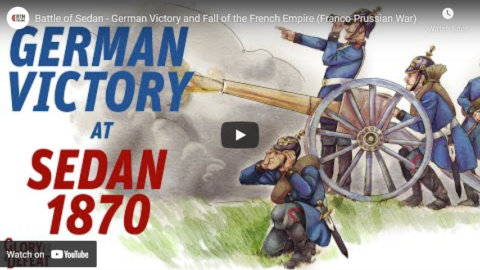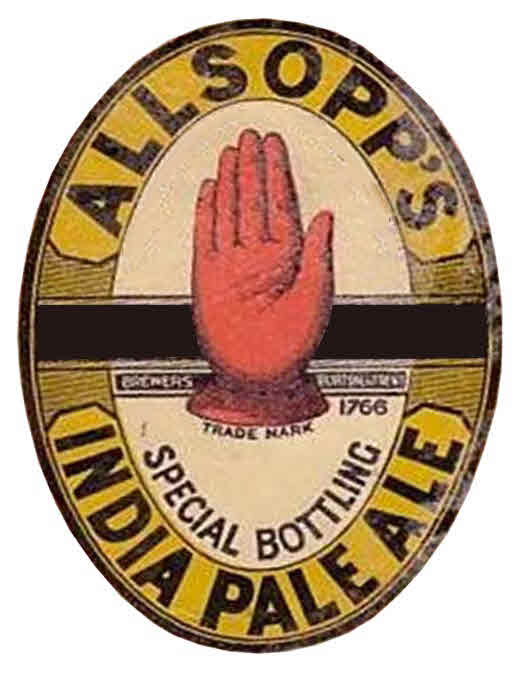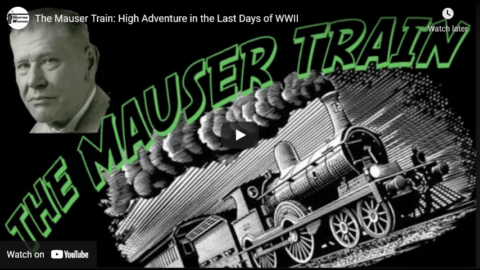realtimehistory
Published 2 Sep 2021The Battle of Sedan was one of the pivotal moments in the 19th century. The French 2nd Empire’s defeat at Sedan (and the capture of Emperor Napoleon III) unleashed social tensions in Paris and a new French republic was proclaimed. And while the victory of the German Armies was resounding, the cost at places like Bazeilles was also high.
» THANK YOU TO OUR CO-PRODUCERS
John Ozment
James Darcangelo
Jacob Carter Landt
Thomas Brendan» OUR PODCAST
https://realtimehistory.net/podcast – interviews with historians and background info for the show.» LITERATURE
Arand, Tobias: 1870/71. Die Geschichte des Deutsch-Französischen Krieges erzählt in Einzelschicksalen. Hamburg 2018Barry, Quintin: The Franco-Prussian War 1870-1871. Vol 1: the Campaign of Sedan. Solihull 2006
Bourguinat, Nicolas/Vogt, Gilles: La guerre franco-allemande de 1870. Une histoire globale. Paris 2020
Gouttman, Alain: La grande défaite de 1870-1871. Paris 2015
Howard, Michael: The Franco-Prussian War. London 1961
Herre, Franz: Eugénie. Kaiserin der Franzosen. Stuttgart, München 2000
Milza, Pierre: L’année terrible. Paris 2009
» SOURCES
Chuquet, Arthur. La Guerre 1870-71. Paris 1895Fontane, Theodor: Der Krieg gegen Frankreich. Bd. Berlin 1874
Kühnhauser, Florian: Kriegs-Erinnerungen eines Soldaten des königlich bayerischen Infanterie-Leib-Regiments. Patenkirchen 1898
N.N. (Hrsg.): Bismarcks Briefe an seine Gattin aus dem Kriege 1870-71. Stuttgart, Berlin 1903
Sheridan, Philip H.: Von Gravelotte nach Paris. Erinnerungen aus dem deutsch-französischen Kriege. Leipzig 1889
» OUR STORE
Website: https://realtimehistory.net»CREDITS
Presented by: Jesse Alexander
Written by: Cathérine Pfauth, Prof. Dr. Tobias Arand, Jesse Alexander
Director: Toni Steller & Florian Wittig
Director of Photography: Toni Steller
Sound: Above Zero
Editing: Toni Steller
Motion Design: Philipp Appelt
Mixing, Mastering & Sound Design: http://above-zero.com
Maps: Battlefield Design
Research by: Cathérine Pfauth, Prof. Dr. Tobias Arand
Fact checking: Cathérine Pfauth, Prof. Dr. Tobias ArandChannel Design: Battlefield Design
Contains licensed material by getty images
All rights reserved – Real Time History GmbH 2021
September 4, 2021
Battle of Sedan – German Victory and Fall of the French Empire (Franco-Prussian War)
Recreating the original India Pale Ale
In The Critic, Henry Jeffreys discusses the rebirth of the original IPA:
From an early age Jamie Allsopp had wanted to bring back the beer that made his family name. It was his ancestor Samuel Allsopp who made the very first Burton IPA, and created a style that is now a global phenomenon. Hell, there are even brewers in Germany making IPA these days.
Though IPA is most associated with Burton-on-Trent, it was originally brewed in London by Hodgson’s, the nearest brewery to East India Dock. Here East India Company servants would buy beer to sell at a vast profit in India. The beer of choice was a strong, heavily-hopped ale designed to last through the winter months. On the six-month voyage through the tropics, it was found to have matured splendidly, rather like wine from Madeira did. Shipped in the early-nineteenth century, this was the first India Pale Ale, though it wasn’t known as such.
Frederick Hodgson then got greedy and tried to cut out the East India Company by shipping directly. So, Campbell Majoribanks, a director at the Company, approached Burton brewer Samuel Allsopp to make a rival beer. Allsopp brewed a sample in a teapot which met with approval and the beer was shipped to India from 1823.
Burton-on-Trent had an advantage over London in that the water contained gypsum, calcium sulphate, which made the beer brighter and clearer with a pronounced acidic bite. It suited a pale crisp beer, made possible by the recent invention of pale malt, very different to the heavy dark porter that London was famed for.
Other Burton brewers such as Bass & Ratcliff got in on the act. This new beer wasn’t just a hit in India; it became all the rage back in Britain. Railways meant that Burton beer could be sent to London cheaply, and the porter that had dominated the capital began to die out, displaced by this new refreshing beer. Some time in the 1830s the name IPA began to be used.
It was the drink of the aspirant middle class. It would have sold for twice as much as ordinary beer. So popular were Burton beers that by 1877 the Bass brewery was the largest in the world. Bass had the red triangle trademark whereas Allsopp’s symbol was the red hand.
The Allsopp family, like many of the great brewing families, moved into politics. Samuel’s son Henry was elevated to the peerage as 1st Baron Hindlip. In fact, so great was the political influence of brewing families that they were known as “the beerage”. Gladstone attributed the liberal defeat in the 1874 election to this powerful faction: “We have been borne down in a torrent of gin and beer”, he wrote.
But the Allsopp’s brewing heyday did not last long. According to Jamie Allsopp, in 1897, the family “built a big lager brewery and nobody wanted lager and it finished the company”. They were pushed out in 1911 when the firm went into receivership. It soldiered on before merging with another Burton brewer, Ind Coope, in 1934. Following waves of mergers and acquisitions, the name and the famous red hand disappeared in 1959.
The Mauser Train: High Adventure in the Last Days of WWII
Forgotten Weapons
Published 18 May 2021http://www.patreon.com/ForgottenWeapons
https://www.floatplane.com/channel/Fo…
Cool Forgotten Weapons merch! http://shop.forgottenweapons.com
Only days ahead of the French Army in April 1945, Ott-Helmuth von Lossnitzer and about 250 Mauser engineers and technicians fled Oberndorf with the core of Mauser’s new projects. They had the drawings, components, and gages for guns like the new StG-45 assault rifle, MK214 aircraft cannon, and Volkspistol and they were headed for an impregnable series of tunnels in the Austrian Alps to carry on the war. In a story that is absolutely worthy of film adaptation they scrounged a series of locomotives, dodged P47 Thunderbolt attacks, and went careening through the Alps with about 2 dozen boxcars of the most important prototype guns in the German arsenal.
Of course, the idea of continued resistance was a complete fantasy. When it did finally arrive in Ötztal, the Mauser refugees found all the tunnels already occupied by other groups with the very same idea. So they basically made camp and waited for American forces to arrive. The train was found by a British-American CIOS (Combined Intelligence Objective Subcommittee) party, the engineers were all questioned, and the train contents packed up for shipment to the UK and US. Ott-Helmuth von Lossnitzer himself emigrated to the US as part of Operation Paperclip, where he worked for Springfield Arsenal for many years until retiring in 1968 and then living in Wisconsin until his passing in 1989.
For anyone interested in this story, I highly recommend Lossnitzer’s oral recollections compiled into book form by Leslie Field and Bas Martens – ISBN 9789081737807. It is out of print now, but you may be able to find it on the secondary market.
Much more accessible is the reprinting of the original CIOS report on Mauser published by Peter Dallhammer (whom you may recall from his Textbook of Pistol Technology and Design). This is a 360-page treasure trove of details on Mauser’s ongoing R&D in 1945, and it is available on Amazon:
https://amzn.to/2RrnNgTContact:
Forgotten Weapons
6281 N. Oracle 36270
Tucson, AZ 85740
QotD: Modern childhood
While it’s hard to argue against safer playgrounds, it’s also true that by design the transparent playground offers kids no privacy. “As [playgrounds] were childproofed to improve safety, they inadvertently reduced the opportunities for the young to take part in forms of fantasy, sensory, and exploratory play, and construction activities apart from adults,” writes historian Mintz. “Unstructured, unsupervised free play outside the home drastically declined for middle-class children. As more mothers joined the labor force, parents arranged more structured, supervised activities for their children. Unstructured play and outdoor activities for children 3 to 11 declined nearly 40 percent between the early 1980s and the late 1990s. Because of parental fear of criminals and bad drivers, middle-class children rarely got the freedom to investigate and master their home turf in ways that once proved a rehearsal for the real world.”
So much for the roving pack of kids each block boasted during Mintz’s childhood, and my own. “The empty lot has disappeared,” he quips. “And we are so concerned with legal liability that if kids do find one, you’d better be sure you’ll get a call from the police.”
Beth Hawkins, “Safe Child Syndrome: Protecting kids to death”, City Pages, Volume 26 – Issue 1267 (posted to the old blog, 2005-03-31).






